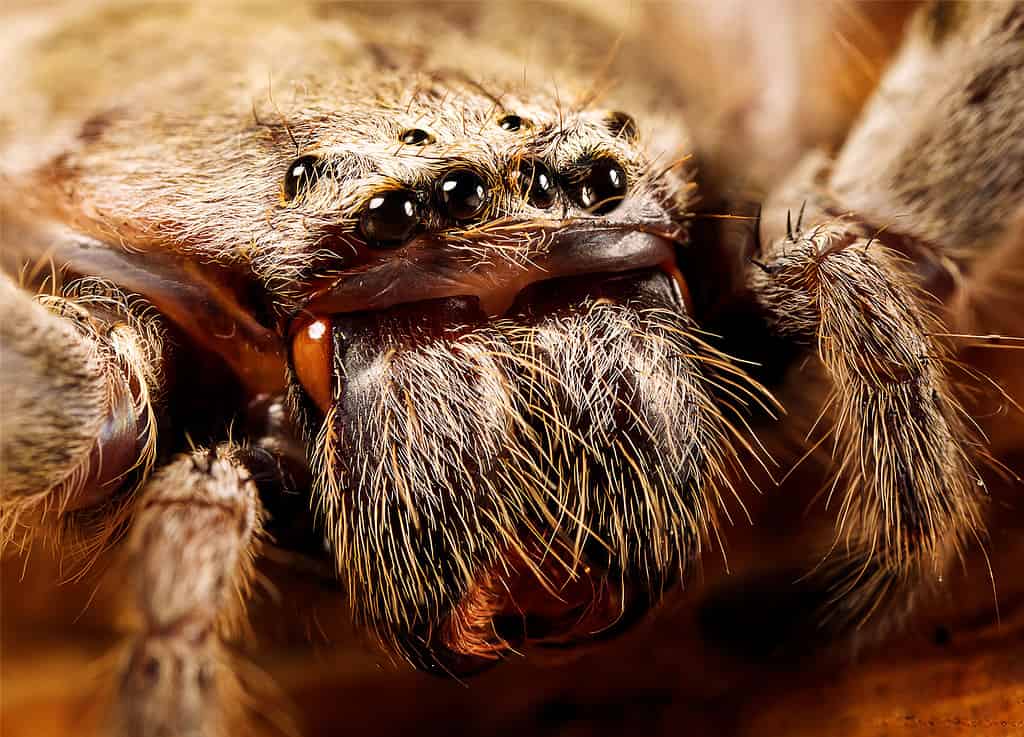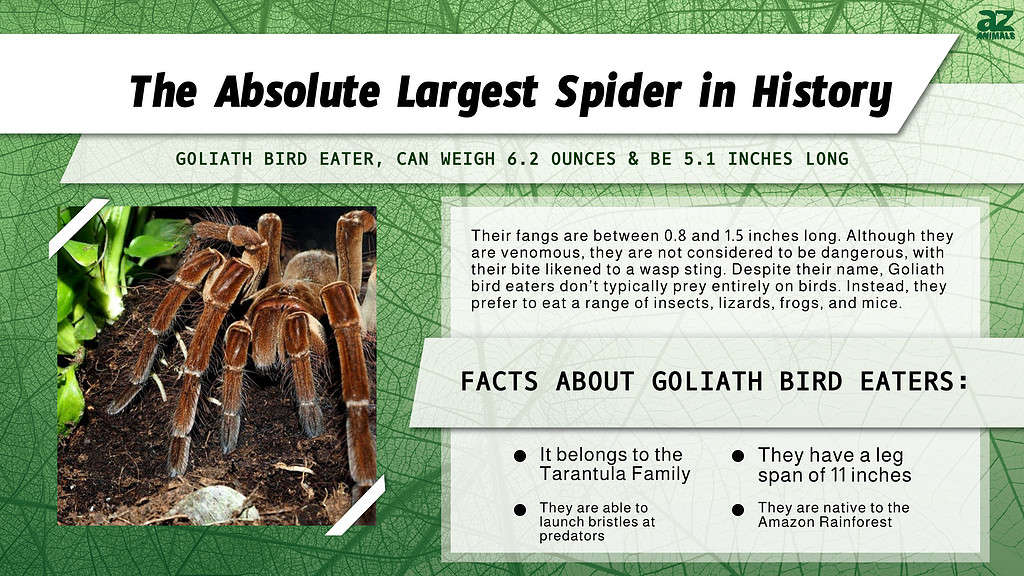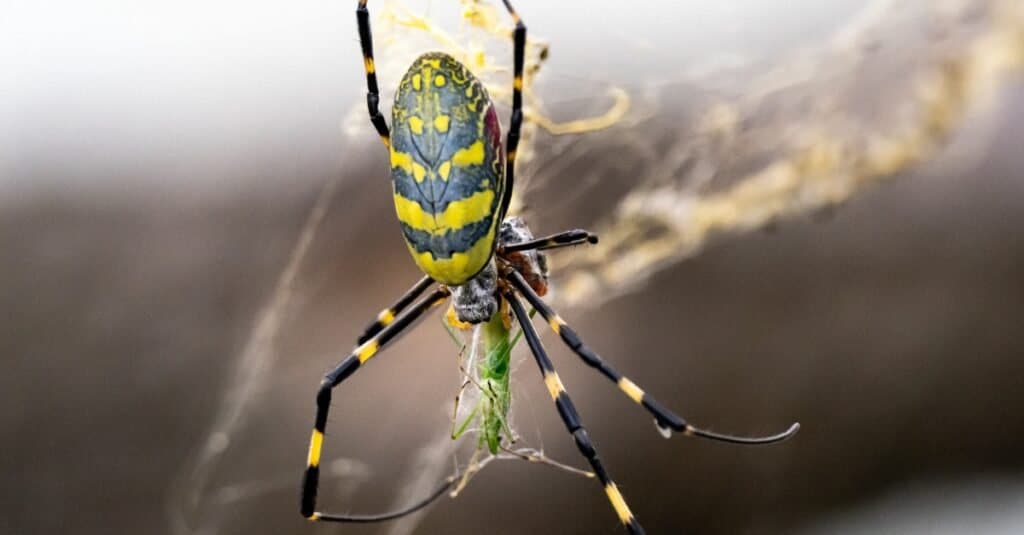Spiders are arachnids that are best known for their distinctive eight-legged appearance. There are around 50,000 different species of spiders that are recognized today. They are found everywhere in the world except Antarctica, and they have adapted to live in a wide variety of habitats.
As there are so many different species, it’s not surprising that spiders can be of vastly different sizes. The smallest spider in the world has a minuscule body, barely the size of a pinhead, but just how big is the biggest?
Join us as we discover the absolute largest spider in history!

Huntsman spiders have the longest leg span.
©Paul Looyen/Shutterstock.com
All about Spiders
Spiders are arachnids from the Araneae order, which are characterized by their eight legs and the ability to produce intricate webs made from silk. Araneae is the largest arachnid order and contains around 130 different family groups. Spiders are known for their diversity and their ability to survive and thrive in a vast range of habitats.
Their color tends to help them to do this. This is because many species share the same color as their main habitat so that they can blend in easily and avoid predators. Spiders also vary in size all the way from the tiniest Patu digua spider, which is only 0.015 inches long, up to the famous tarantulas, which can have a body the size of a human hand.
Although it’s commonly assumed that all spiders capture their prey using their web, different species use different methods. While some do use their webs to catch prey, others are ambush predators, while others mimic plants or even ants.
Depending on the size of the spider, prey can be anything from tiny insects to birds or rodents. Almost all spiders have two hollow fangs, which they use to inject venom into their prey. However, the majority of spiders are not actually considered to be dangerous to humans. This is because most have venom that is too weak to do any harm.
Spiders reproduce by laying eggs, and females can lay several hundred eggs at one time. Incredibly, females then wrap their eggs in an egg sac which they either leave in the web or carry around everywhere they go. Depending on the species, this egg sac can be as large as a tennis ball!

Where Do Spiders Live?
Spiders can be found all over the world in a wide variety of habitats.
Some species live in trees, while others live in underground burrows or caves. Some spiders are found in deserts, while others are found in rainforests or other humid environments.
Many spiders live in or near human habitation, such as in homes, gardens, or other man-made structures. Some species are also aquatic, living in freshwater or marine environments.
Spiders are known to be found in a wide range of habitats and are known to be able to adjust to new environments.
The Largest Spider in History

The Goliath birdeater is the world’s largest spider by weight.
©juerginho/Shutterstock.com
The absolute largest spider in history is the Goliath bird eater (Theraphosa blondi), which is the largest spider alive today by length and weight. It weighs around 6.2 ounces and can reach body lengths of up to an incredible 5.1 inches – easily making it one of the most fearsome and intimidating spiders in the world. It also has a leg span of up to 11 inches and is typically a light brown or tan color. Goliath bird eaters are native to South America – particularly the Amazon rainforest – and live in burrows near marshes or swamps.
Goliath bird eaters are a member of the tarantula family and have fangs between 0.8 and 1.5 inches long. Although they are venomous, they are not considered to be dangerous, with their bite likened to a wasp sting. Despite their name, Goliath bird eaters don’t typically prey entirely on birds. Instead, they prefer to eat a range of insects, lizards, frogs, and mice.
Once they’ve caught their prey, they drag it back to their burrow to eat. However, they don’t just tuck straight in. Instead, these massive spiders inject toxins into their prey which liquefies its insides. They just literally suck everything out of it, which only adds to their fearsome reputation.
Although goliath bird eaters don’t have a particularly strong venom, they do have an effective – if rather unusual – defense mechanism…they launch bristles at predators! This surprising action can be harmful to both the skin and mucous membranes. However, it is usually only used as a last resort. Goliath bird eaters also rub their hairs together to create a loud hissing noise. This can be heard as far away as 15 feet!
What about Leg Span?
Although goliath bird eaters are considered to be the largest spiders in the world, giant huntsmen just manage to beat them for leg span.
Giant huntsmans have a massive one-foot leg span, and their legs are incredibly long compared to their bodies. Giant huntsmans are the largest among the huntsman spiders. However, their bodies themselves are only small at 1.8 inches long.
Giant huntsmans are native to Laos, where they tend to dwell in caves – typically near cave entrances. They don’t catch their prey on webs. Instead, they utilize their long legs and chase down their prey. Their diet generally consists of anything smaller than them that they can catch and eat.
The Largest Spider that Never was

The largest extinct spiders are closely related to modern golden orb weavers.
©iStock.com/David Hansche
If the thought of the goliath bird eater isn’t already terrifying enough, then imagine a beast more fearsome than any spider in existence. Imagine a spider with a foot-long body and a leg span of a foot and a half. Discovered in a 300 million-year-old rock from Argentina, Megarachne servinei was coined as the largest spider that had ever existed, and indeed it was…until it wasn’t.
From its discovery in 1980 until 2005, Megarachne servinei was widely known as the largest spider ever. Despite appearing to be spider-like, scientists couldn’t pinpoint why it lacked certain distinctive spider characteristics.
However, in 2005 another Megarachne specimen was discovered, and after much study, the truth was finally known. Incredibly, rather than being a giant spider, Megarachne is actually a previously unknown sea scorpion. This revelation quickly reinstated the goliath bird eater back to the status of the largest spider and rewrote the history books.
With the reclassification of Megarachne, the largest known extinct spider – and the largest fossilized spider – is now Nephilia jurassica. Nephilia jurassica is closely related to the existing golden orb weaver spiders and dates back 165 million years.
However, compared to the spider that never was – and indeed the largest spider today – Nephilia jurassica was nowhere near giant size. Instead, they had 1-inch bodies and a 5-inch leg span. This means that goliath bird eaters look set to keep their position at the top for the foreseeable future.
The Most Venomous Spider
The Sydney funnel-web spider, Atrax robustus, is a species of venomous spider native to Australia. It has earned the title of the most dangerous spider to humans in the world, according to the Guinness World Records. While these spiders can be found in many moist habitats, such as under logs or gardens, they are also known for their aggressive behavior when disturbed.
Their large size and fangs make them particularly intimidating for those who encounter them in person. The venom produced by this species is highly toxic and can cause serious health problems if not treated quickly enough. However, an effective antivenom exists that helps reduce mortality rates associated with bites from this spider.
The photo featured at the top of this post is © juerginho/Shutterstock.com
Thank you for reading! Have some feedback for us? Contact the AZ Animals editorial team.







